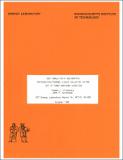Cost goals for a residential photovoltaicthermal liquid collector system set in three northern locations
Author(s)
Dinwoodie, Thomas L.; Kavanaugh, John P.
DownloadEL_TR_1980_028.pdf (2.879Mb)
Alternative title
A residential photovoltaic/thermal liquid collector system set in three northern locations, Cost goals for.
Metadata
Show full item recordAbstract
This study compares the allowable costs for a residential PV/T liquid collector system with those of both PV-only and side-by-side PV and thermal collector systems. Four types of conventional energy systems provide backup: all oil, all gas, all electric resistance, and electric resistance hot water with space heating by parallel heat pump. Electric space cooling is modeled, and the electric utility serves as backup for all electrical needs. The analysis is separated into two parts. The first is a base case study using conservative market and financial parameters for comparing PV/T economics in three northern locations: Boston, Madison, and Omaha. All parameter estimates are for a privately purch.-sed residence, newly constructed in 1986. Three measures are used for establishing allowable costs, including system breakeven capital cost, al.owable levelized annual costs, and an allowable combined collector cost when compared directly with a side-by-side collector system. In the second portion of this study we examine the sensitivity of PV/T economics to pertinent physical, market, and financial variables. Here also we estimate the difference in economic outlook for PV/T in retrofit applications. The results indicate that, for those northern locations modeled, the allowable cost for a combined collector system is roughly $10-$30/m2 less than that of separate (side-by-side) collector systems, at total array areas between 40-80 m . Below this range, allowable costs diverge, benefiting optimally sized separate collector systems. All systems look best when operating against all-electric homes. Retrofit applications appear favorable over newly designed homes, although here there is need to assess alternative retrofit options such as conservation.
Date issued
1980Publisher
Cambridge, Mass. : Massachusetts Institute of Technology, Energy Laboratory, 1980
Series/Report no.
Energy Laboratory report (Massachusetts Institute of Technology. Energy Laboratory) no. MIT-EL 80-028.